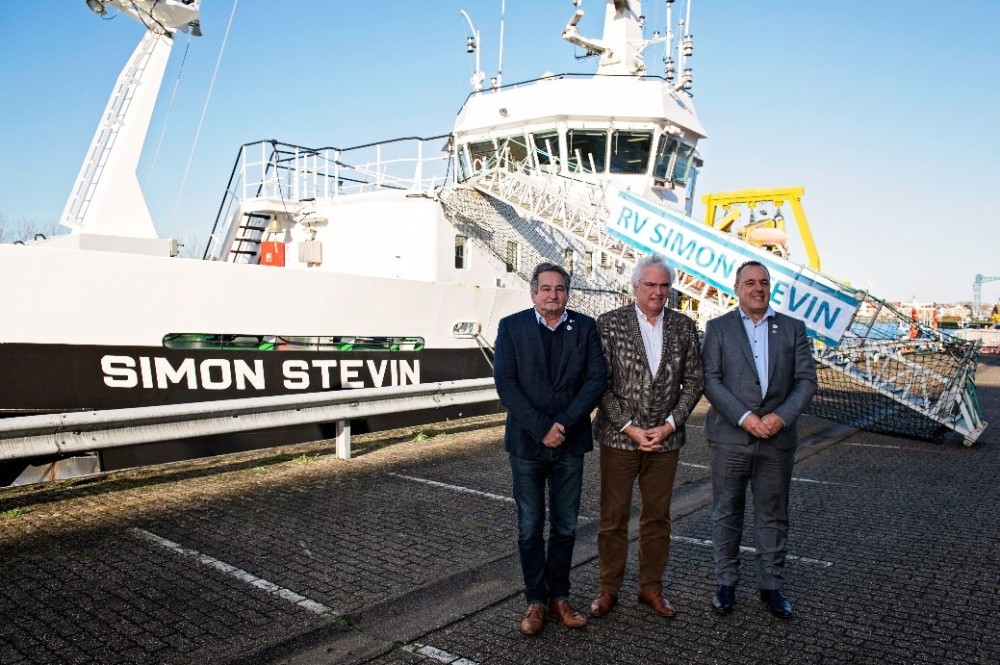We are writing 1999, the founding year of the VLIZ. At that time, since 1984, the RV Belgica has been the only research ship in our country. However, the ship time requested by scientists far exceeds what the Belgica can accommodate. Therefore, the new VLIZ was only too happy to welcome the offer of Jan Strubbe, then Director General of the Administration of Waterways and Maritime Affairs (AWZ) and a member of the VLIZ Board of Directors, to donate the pilot boat 'Zeeleeuw' to the young institute and make it available for marine research. VLIZ and VLOOT rebuild the Zeeleeuw (at the time 23 years old) to meet a great need for ship time. At a stroke, 150 additional ship days were freed up for marine scientific research!
Yet it soon becomes clear that another gear needs to be shifted up. A converted pilot boat cannot perform all the desired tasks. A feasibility study of potential users followed in 2005. This showed that a new, 30-40 m long 'inshore' vessel, complementary to the RV Belgica, could remedy 70% of the more than two thousand working days at sea. So in 2007, the Flemish government decides to build a state-of-the-art sailing platform, the later RV Simon Stevin. It involves an investment of EUR 12,000,000, of which VLOOT contributes EUR 3,000,000 and VLIZ EUR 1,000,000. As was already the case with the RV Zeeleeuw, VLOOT will take care of the operational functioning and crew. VLOOT's unique expertise and shipbuilding experience proved indispensable from day one. VLIZ takes care of the scientific programme, gratefully making use of its network within the marine research world.

Operator at VLIZ, André Cattrijsse: "The Simon Stevin was the first European research vessel within its class with dynamic positioning, a silent noise profile and with a capacity to serve large aircraft. It is still regarded within the European research fleet as a very capable ship for coastal research."
Ten years later, the balance sheet can be taken. And it looks extremely positive. At 170-180 sailing days per year, the counter in 2023 stands at almost 2000 realized days at sea. The scientific output translates into more than 400 publications with the mention 'RV Simon Stevin'. The extra ship capacity creates more research at sea, causing a chicken and egg effect, so to speak. The research vessel provides additional opportunities and generates more projects. And more projects submitted and honored leads to more need for ship time. The complementarity with the RV Belgica reinforces this research bonus. It also fuels Flemish-federal cooperation and leads to an exchange of equipment between the two sailing platforms.
Frank Aerssens, acting director of VLOOT: "A fascinating and challenging project from the very beginning, more than ten years ago now, with the construction process of this beautiful and above all progressive ship. Meanwhile, the Simon Stevin has grown into a solid teenager with tons of experience, extreme contributions to the scientific world, but above all wonderful teamwork between VLOOT and VLIZ. And we can only applaud that. Together on to another decade!"
But there is more. The long-term high-frequency monitoring program of the Belgian part of the North Sea, started with the RV Zeeleeuw in 2001 and continued by the RV Simon Stevin, not only provides a wealth of data. It also provides access to larger projects such as the European LifeWatch and the ICOS program. Within ICOS, the RV Simon Stevin meanwhile acts as an internationally recognized ICOS climate research monitoring station, as does the VLIZ monitoring buoy that can only be kept operational subject to the vessel's deployment. Also, the RV Simon Stevin undeniably offers opportunities for internationalization of VLIZ's activities. Anchoring in platforms or projects such as ERVO, Eurofleets and EMBRC allows useful contacts to be established abroad with operators of often much larger vessels. It also gives access to technical assistance where needed. Thanks to the RV Simon Stevin as a carrier, VLIZ can build a high-performance 'Marine Robotic Centre' in Ostend, with various robots deployable from the ship. The ship also creates many opportunities in the deployment of a scientific diving team, and in testing and upgrading seismic and other techniques (e.g. vibro-corer, video plankton recorder - VPR). In addition, with an average of 25 educational sailings per year, the RV Simon Stevin fulfills its role as a training vessel, both for universities and colleges, and for younger ages. And finally, for ten years the RV Simon Stevin has been the showpiece at public activities of the VLIZ and VLOOT (Science Day, Planet Sea competition, press moments, Port Day,...).
With the 10-year anniversary of the RV Simon Stevin just behind us, the 15-year anniversary is already in sight. A not insignificant milestone, to an age when a ship is due for renovation or modification and to look ahead into what the future holds.